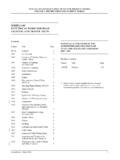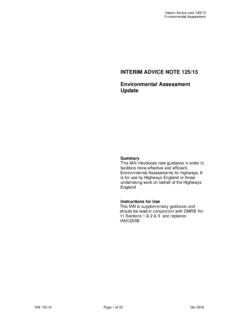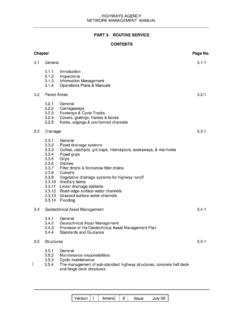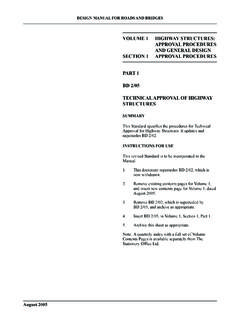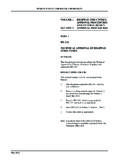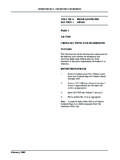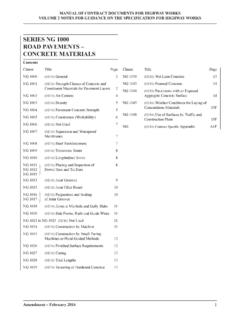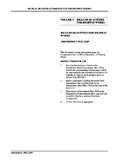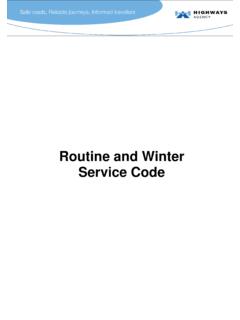Transcription of SERIES 700 ROAD PAVEMENTS – GENERAL OVERSEEING ...
1 MANUAL OF CONTRACT DOCUMENTS FOR HIGHWAY WORKS VOLUME 1 SPECIFICATION FOR HIGHWAY WORKS1 Amendment February 2016 SERIES 700 ROAD PAVEMENTS GENERALC ontentsClause Title Page700 (02/16) GENERAL 2701 (02/16) Pavement Construction 2#702 (02/16) Horizontal Alignments, Surface Levels and Surface Regularity of Pavement Courses 2703 to 705 (02/16) Not used 5#706 (02/16) Excavation, Trimming and Reinstatement of Existing Surfaces 5707 (02/16) Breaking Up or Perforation of Redundant Pavement 7708 (02/16) Not used 7709 (02/16) Cold-milling (Planing) of Bituminous Bound Flexible Pavement 7710 (02/16) Testing for Constituent Materials in Recycled Aggregate and Recycled Concrete Aggregate 8711 (02/16) Overband and Inlaid Crack Sealing Systems 8712 (02/16) Maintenance of Arrester Beds 9713 (02/16) Saw-cut and Seal Bituminous Overlays on Existing Jointed Concrete PAVEMENTS 9714 (02/16) Preparation of Jointed Concrete PAVEMENTS Prior to Overlaying and Saw-cut and Seal of the Bituminous Overlays 10715 (02/16) Saw-cut, Crack and Seat Existing Jointed Reinforced Concrete PAVEMENTS 11716 (02/16) Cracking and Seating of Existing Jointed Unreinforced Concrete PAVEMENTS and Hydraulically Bound Mixture (HBM) Bases 20717 (02/16) Monitoring of Cracked and Seated Jointed Unreinforced Concrete PAVEMENTS and HBM Bases Using the falling weight deflectometer (FWD) 28718 (02/16) Monitoring of Saw-cut, Cracked and Seated Jointed Reinforced Concrete PAVEMENTS Using the falling weight deflectometer (FWD) 31 Clause Title Page719 (02/16) Back-analysis of falling weight deflectometer (FWD)
2 Measurements Made on Concrete PAVEMENTS Treated by Fractured Slab Techniques 34 NATIONAL ALTERATIONS OF THE OVERSEEING ORGANISATIONS OF SCOTLAND, WALES AND NORTHERN IRELANDN orthern Ireland702NI (02/16) Horizontal Alignments, Surface Levels and Surface Regularity of Pavement Courses N1706NI (02/16) Excavation, Trimming and Reinstatement of Existing Surfaces N4# denotes a Clause or Sample Contract Specific Appendix which has a substitute National Clause or Sample Contract Specific Appendix for one or more of the OVERSEEING Organisations of Scotland, Wales or Northern February 2016 Volume 1 SERIES 700 Specification for Highway Works Road PAVEMENTS GeneralROAD PAVEMENTS GENERAL700 (02/16) General1 (02/16) This SERIES is part of the Specification for Highway Works. Whilst this SERIES is particularly relevant to the subject matter in its title it must be read in conjunction with the GENERAL requirements in SERIES 000 and 100 and with all other SERIES relevant to the specification for the particular works to be (02/16) Pavement Construction1 (02/16) Road PAVEMENTS shall be constructed from one of the permitted options described in contract specific Appendix 7/1 and in compliance with this SERIES and the appropriate Clauses of SERIES 800, 900 and (02/16) The Contractor shall, in his choice of permitted materials for subbases and bases, have regard to the nature of those materials and of the subgrade or any capping and the need to protect them from deterioration due to the ingress of water, the adverse effects of weather and the use of constructional plant.
3 The Contractor shall programme the laying and compaction of the subbase and the subsequent pavement courses and take such other steps as may be considered necessary, to afford protection to the base, subbase and subgrade.#702 (02/16) Horizontal Alignments, Surface Levels and Surface Regularity of Pavement Courses Horizontal Alignments1 (02/16) Horizontal alignments shall be determined from one edge of the pavement surface as described in contract specific Appendix 1/12. The edge of the pavement as constructed and all other parallel alignments shall be correct within a tolerance of 25 mm therefrom, except for kerbs and channel blocks which shall be laid with a smooth alignment within a tolerance of 13 mm. Longitudinal road markings lateral tolerance shall be in accordance with sub-Clause (02/16) Surface Levels of Pavement Courses2 The design levels of pavement courses shall be calculated from the vertical profile, crossfalls and the pavement course thicknesses described in contract specific Appendix 7/1.
4 The level of any point on the constructed surface of the pavement courses shall be the design level subject to the appropriate tolerances stated in Table 7 7/1: (02/16) Tolerances in Surface Levels of Pavement CoursesRoad surfaces GENERAL adjacent to a surface water channel* 6 mm+ 10 0 mmBinder course * 6 mmBase * 15 mmSubbase under concrete pavement surface slabs laid full thickness in one operation by machines with surface compaction 10 mmSubbases other than above+ 10 30 mm* Where a surface water channel is laid before the adjacent road pavement layer the top of that layer, measured from the top of the adjacent edge of the surface water channel, shall be to the tolerances given in Table 7 (02/16) Notwithstanding the tolerances permitted in surface levels of pavement courses, the cumulative tolerance shall not result in a reduction in thickness of the pavement, excluding the subbase, by more than 15 mm from the specified thickness nor a reduction in the thickness of the bituminous surface course by more than 5 mm from that February 20163 Volume 1 SERIES 700 Specification for Highway Works Road PAVEMENTS General4 (02/16) For checking compliance with sub-Clause 2 of this Clause, measurements of the surface levels of all courses will be taken on a grid of points located as described in contract specific Appendix 7/1.
5 In any length of pavement, compliance shall be deemed to be met for all surfaces, other than the final road surface, when not more than one of ten consecutive measurements taken longitudinally or one in any transverse line, exceeds the tolerances permitted in Table 7/1, provided that this one measurement shall not exceed by more than 5 mm the tolerance for the course concerned. For the final road surface the tolerance given in Table 7/1 shall apply to any point on that surface.(02/16) Surface Regularity5 (02/16) The longitudinal regularity of the surfaces of surface courses, binder courses and concrete slabs shall be such that the number of surface irregularities is within the relevant limits stated in Table 7 irregularity is a variation of not less than 4 mm or not less 7 mm of the profile of the road surface as measured by the rolling straight-edge set at 4 mm or 7 mm as appropriate, or equivalent apparatus capable of measuring irregularities within the same magnitudes over a 3 m length.
6 No irregularity exceeding 10 mm shall be (02/16) Prior to checking any final road surface, binder course or top surface of base in PAVEMENTS without binder course for level, regularity or macrotexture depth, it shall be cleaned of loose or extraneous materials. These operations shall be carried out without damaging the surface of the pavement, as soon as possible and within 3 days of construction of the (02/16) Compliance with Table 7/2 shall be checked by the rolling straight-edge along any line or lines parallel to the edge of pavement on sections of 300 m at regular intervals as stated in contract specific Appendix 7/1, whether or not it is constructed in shorter lengths. Sections shorter than 300 m forming part of a longer pavement shall be assessed using the number of irregularities for a 300 m length pro-rata to the nearest whole the total length of pavement is less than 300 m, the measurements shall be taken on 75 m (02/16) PAVEMENTS shall be measured transversely for irregularities at regular intervals as stated in contract specific Appendix 7/1, by a 3 m long straight-edge in accordance with BS 8420 placed at right angles to the centre line of the road.
7 The maximum allowable difference between the pavement surface and the straight-edge shall be 3 (02/16) A straight-edge 3 metres long, shall be used to check longitudinal surface regularity in the following cases:(i) for lengths of less than 75 m of surface course, binder course and concrete slabs;(ii) where use of the rolling straight-edge or equivalent apparatus is impracticable;(iii) for all lengths of subbase under concrete pavement slabs laid full thickness in one operation by machine with surface maximum allowable difference between the surface and the underside of the straight-edge, when placed parallel with, or at right angles to, the centre line of the road shall be:for pavement surfaces 3 mmfor binder courses 6 mmfor subbases under concrete PAVEMENTS (as in (iii) above) 10 mm4 Amendment February 2016 Volume 1 SERIES 700 Specification for Highway Works Road PAVEMENTS GeneralTABLE 7/2.
8 (02/16) Maximum Permitted Number of Surface IrregularitiesSurfaces of each lane of carriageway, each hard strip and each hard shoulder for each irregularity limitSurfaces of each lane of bituminous binder courses for carriageway, hard strip and hard shoulder for each irregularity limitSurfaces of lay-bys, service areas, and associated bituminous binder courses for each irregularity limitIrregularity Limits4 mm7 mm4 mm7 mm4 mm7 mmLength (m)300753007530075300753007530075 Category A* Roads20921401842401842 Category B* Roads401842602763602763* The Category of each section of road is described in contract specific Appendix 7/1.(02/16) Rectification10 (02/16) Where any pavement area does not comply with the specification for regularity, surface tolerance, thickness, macrotexture depth, material properties or compaction, the full extent of the area which does not comply with the specification shall be made good and the surface of the pavement course shall be rectified in the manner described below:(i) Unbound and hydraulically bound materialsThe top 75 mm shall be scarified, reshaped with material added or removed as necessary, and re-compacted.
9 The area treated shall be not less than 20 m long and 2 m wide. For hydraulically bound materials, all rectification shall be completed within 48 hours of the binder being added to the material.(ii) Cement bound subbases and basesThe method of correction will depend on the period which has elapsed between detection of the error and the time of mixing of the material. If this is less than 4 hours, the surface shall be scarified to a depth of not less than 50 mm, surplus material removed or freshly mixed material added as necessary, and re-compacted in accordance with the specification. If the period is 4 hours or more the full depth of the layer shall be removed from the pavement and replaced with material in accordance with the specification. In either case the area treated shall be at least 5 m long and the full width of the paving laid in one operation. If the Contractor proposes rectification within 7 days of laying he shall comply with Clause 1048.
10 Alternatively, for subbases under concrete PAVEMENTS the Contractor may make up low areas to a level within the tolerances of this Clause with a 1:4 cement and sand mortar or with an AC4 fine surface course complying with Clause 914.(iii) Bituminous basesWith coated macadam or asphalt bases, the full depth of the top layer as laid shall be removed and be replaced with fresh material laid and compacted in accordance with the specification. Any area so treated shall be at least 5 m long and the full width of the paving laid in one operation. Alternatively for low areas in bituminous bases, the Contractor may make up the level with additional binder course material.(iv) Surface courses and binder coursesThese shall have the full depth of the course removed and replaced with fresh material laid and compacted in accordance with the area rectified shall be the full width of the paving laid in one operation, and at least 5 m long if binder course, or 15 m if surface the number of surface irregularities exceeds the limits in Table 7/2, the area to be rectified shall be 300 m or 75 m long as appropriate and the full width of the lanes affected.
